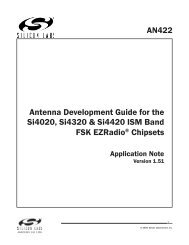C8051F326/7 - Silicon Labs
C8051F326/7 - Silicon Labs
C8051F326/7 - Silicon Labs
You also want an ePaper? Increase the reach of your titles
YUMPU automatically turns print PDFs into web optimized ePapers that Google loves.
1. System Overview<br />
<strong>C8051F326</strong>/7<br />
<strong>C8051F326</strong>/7 devices are fully integrated mixed-signal system-on-a-chip MCUs. Highlighted features are<br />
listed below. Refer to Table 1.1 for specific product feature selection.<br />
• High-speed pipelined 8051-compatible microcontroller core (up to 25 MIPS)<br />
• In-system, full-speed, non-intrusive debug interface (on-chip)<br />
• Universal serial bus (USB) function controller with three fixed-function endpoint pipes, integrated transceiver,<br />
and 256B FIFO RAM<br />
• Supply voltage regulator<br />
• Precision programmable 12 MHz internal oscillator and 4x clock multiplier<br />
• 16k kB of on-chip Flash memory<br />
• 1536 total bytes of on-chip RAM (256 + 1 k + 256 USB FIFO)<br />
• Enhanced UART, serial interfaces implemented in hardware<br />
• Two general-purpose 16-bit timers<br />
• On-chip power-on reset, VDD monitor, and missing clock detector<br />
• 15 Port I/O (5 V tolerant)<br />
With on-chip power-on reset, VDD monitor, voltage regulator, and clock oscillator, <strong>C8051F326</strong>/7 devices<br />
are truly stand-alone System-on-a-Chip solutions. The Flash memory can be reprogrammed in-circuit, providing<br />
non-volatile data storage, and also allowing field upgrades of the 8051 firmware. User software has<br />
complete control of all peripherals, and may individually shut down any or all peripherals for power savings.<br />
The on-chip <strong>Silicon</strong> Laboratories 2-Wire (C2) Development Interface allows non-intrusive (uses no on-chip<br />
resources), full speed, in-circuit debugging using the production MCU installed in the final application. This<br />
debug logic supports inspection and modification of memory and registers, setting breakpoints, single<br />
stepping, run and halt commands. All analog and digital peripherals are fully functional while debugging<br />
using C2. The two C2 interface pins can be shared with user functions, allowing in-system debugging without<br />
occupying package pins.<br />
Each device is specified for 2.7–5.25 V operation over the industrial temperature range (–40 to +85 °C).<br />
For voltages above 3.6 V, the on-chip Voltage Regulator must be used. A minimum of 3.0 V is required for<br />
USB communication. The Port I/O and RST pins are tolerant of input signals up to 5 V. <strong>C8051F326</strong>/7 are<br />
available in two 28-pin QFN packages with different pinouts. The RoHS compliant devices are marked with<br />
a -GM suffix in the part number. The port I/O on <strong>C8051F326</strong> devices is powered from a separate I/O supply<br />
allowing it to interface to low voltage logic.<br />
Ordering Part<br />
Number<br />
MIPS (Peak)<br />
Table 1.1. Product Selection Guide<br />
Flash Memory<br />
RAM<br />
Calibrated Internal<br />
Oscillator<br />
USB<br />
Supply Voltage<br />
Regulator<br />
<strong>C8051F326</strong>-GM 25 16k 1536 2 15 QFN-28<br />
C8051F327-GM 25 16k 1536 2 15 — QFN-28<br />
UART<br />
Timers (16-bit)<br />
Digital Port I/Os<br />
Separate I/O Supply<br />
Package<br />
Rev. 1.1 13


